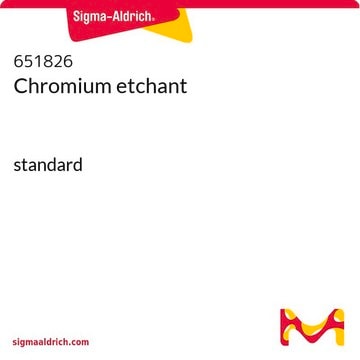Products may be shipped at a different temperature than the recommended long-term storage temperature. If the product quality is sensitive to short-term exposure to conditions other than the recommended long-term storage, it will be shipped on wet or dry-ice. If the product quality is NOT affected by short-term exposure to conditions other than the recommended long-term storage, it will be shipped at ambient temperature. As shipping routes are configured for minimum transit times, shipping at ambient temperature helps control shipping costs for our customers. For more information, please refer to the Storage and Transport Conditions document: https://www.sigmaaldrich.com/deepweb/assets/sigmaaldrich/marketing/global/documents/316/622/storage-transport-conditions-mk.pdf
650501
Acetona
HPLC Plus, for HPLC, GC, and residue analysis, ≥99.9%
About This Item
HPLC grade
for residue analysis
gas chromatography (GC): suitable
Productos recomendados
grade
HPLC Plus
HPLC grade
for residue analysis
Quality Level
agency
suitable for EPA 1613
suitable for EPA 1633
vapor density
2 (vs air)
vapor pressure
184 mmHg ( 20 °C)
assay
≥99.9%
form
liquid
expl. lim.
13.2 %
technique(s)
HPLC: suitable
gas chromatography (GC): suitable
impurities
≤0.5% water
≤1.0 ppb Fluorescence (quinine) at 365 nm
evapn. residue
≤0.0003%
halogenated residue
<10 ng/L (as heptachlor epoxide)
refractive index
n20/D 1.359 (lit.)
pH
5-6 (20 °C, 395 g/L)
bp
56 °C/760 mmHg (lit.)
mp
−94 °C (lit.)
solubility
water: miscible
density
0.791 g/mL at 25 °C (lit.)
λ
H2O reference
UV absorption
λ: 330 nm Amax: 1.0
λ: 340 nm Amax: 0.06
λ: 350 nm Amax: 0.01
λ: 375-400 nm Amax: 0.005
application(s)
food and beverages
format
neat
SMILES string
CC(C)=O
InChI
1S/C3H6O/c1-3(2)4/h1-2H3
InChI key
CSCPPACGZOOCGX-UHFFFAOYSA-N
¿Está buscando productos similares? Visita Guía de comparación de productos
General description
Application
- Evaluación espectroscópica mediante resonancia magnética nuclear del metabolismo de la glucosa en muestras biológicas (sangre).[5]
- Preparación de una disolución amorfa de poli(ácido láctico) (PLA) al 13% en peso, que se necesitó para la preparación de las membranas de PLA electrohiladas.[6]
- Como precursor para la síntesis de isobutilmetilcetona (MIBK) en presencia del catalizador óxido de grafeno sulfonado-Pd/cordierita.[7]
- Síntesis del (4-hidroximetil-2,2-dimetil-1,3-dioxolano), un solketal del glicerol utilizando tecnología de fluidos supercríticos (SCF).[8]
signalword
Danger
hcodes
Hazard Classifications
Eye Irrit. 2 - Flam. Liq. 2 - STOT SE 3
target_organs
Central nervous system
supp_hazards
Storage Class
3 - Flammable liquids
wgk_germany
WGK 1
flash_point_f
-6.2 °F
flash_point_c
-21.2 °C
Elija entre una de las versiones más recientes:
¿Ya tiene este producto?
Encuentre la documentación para los productos que ha comprado recientemente en la Biblioteca de documentos.
Artículos
Compare PAH determination in olive oil: traditional GB 5009.265-2021 method vs. faster, simpler SPE with Supelclean™ EZ-POP NP; both meet criteria.
Substances are said to be miscible in one another if they dissolve to form a uniform solution. Bookmark or download our miscibility table for common lab solvents.
Se dice que las sustancias son miscibles entre sí si se disuelven hasta formar una disolución uniforme. Marque o descargue nuestra tabla de miscibilidad para los disolventes comunes del laboratorio.
Contenido relacionado
This page is intended to make it easier to find the consumables you need based on the analytical method you’re using. Methods included on this page come from the EPA, Standard Methods and ASTM.
-
How is shipping temperature determined? And how is it related to the product storage temperature?
1 answer-
Helpful?
-
-
How can I determine the shelf life / expiration / retest date of this product?
1 answer-
If this product has an expiration or retest date, it will be shown on the Certificate of Analysis (COA, CofA). If there is no retest or expiration date listed on the product's COA, we do not have suitable stability data to determine a shelf life. For these products, the only date on the COA will be the release date; a retest, expiration, or use-by-date will not be displayed.
For all products, we recommend handling per defined conditions as printed in our product literature and website product descriptions. We recommend that products should be routinely inspected by customers to ensure they perform as expected.
For products without retest or expiration dates, our standard warranty of 1 year from the date of shipment is applicable.
For more information, please refer to the Product Dating Information document: https://www.sigmaaldrich.com/deepweb/assets/sigmaaldrich/marketing/global/documents/449/386/product-dating-information-mk.pdfHelpful?
-
-
quel est origine de l'acétone HPLC? synthèse, biosourcing?
1 answer-
This product is typically manufactured as synthetic organic, however, may vary lot to lot. This information can be found on the lot specific Certificate of Origin. Please navigate to the ‘DOCUMENTATION’ section of the Product Detail Page to access a Certificate under the ‘Certificate of Origin’ tab:
https://www.sigmaaldrich.com/product/sigald/650501#product-documentationHelpful?
-
Active Filters
Nuestro equipo de científicos tiene experiencia en todas las áreas de investigación: Ciencias de la vida, Ciencia de los materiales, Síntesis química, Cromatografía, Analítica y muchas otras.
Póngase en contacto con el Servicio técnico




